

Opisthorchis felineus (Pathogen – Liver Trematodes)
Organism:
Opisthorchis felineus infections in humans have been reported from Poland, Germany, the Russian Federation, and Kazakhstan, with the largest area of endemicity being found in western Siberia. Over 1.5 million people are infected, with some prevalence rates reaching 95%. The first report of a human infection was in 1892.
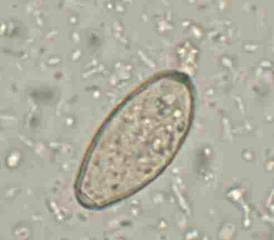 |
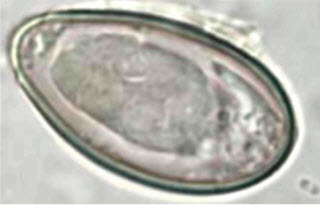 |
| Eggs (operculated) |
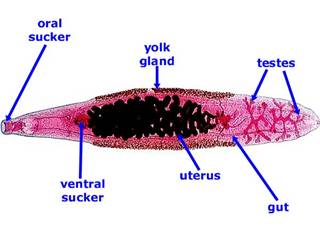 |
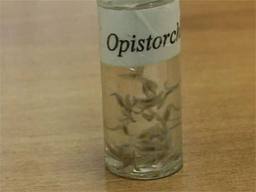 |
| Adult worm | Adult worms |
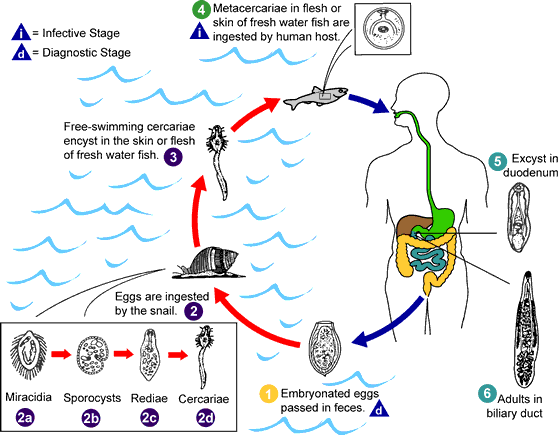
Life Cycle:
Although the miracidium larva is fully developed when the egg is laid, hatching occurs only after ingestion by the snail intermediate host. Apparently, the only known molluscan host is the snail Cordiella (Bithynia), in which the first‑ and second‑generation sporocysts and rediae develop. The cercariae leave the snail host and then encyst within the tissues of freshwater fish in the carp family. More than twenty species from 17 genera of freshwater fish serve as second intermediate hosts. Humans, cats, and other reservoir hosts become infected after ingestion of raw or poorly cooked fish. The metacercariae excyst in the duodenum, migrate to the distal bile passages, attach, and begin egg production within 3 to 4 weeks. The adult worm lives attached in the biliary and pancreatic ducts of the host. The adult worm is lancet‑shaped and measures from 7 to 12 mm in length, which is larger than the adult worms of O. viverrini.
Acquired:
Humans become infected by ingesting the metacercariae in uncooked fish.
Epidemiology:
In central, eastern, and southeastern Europe, the Russian Federation, and Kazakhstan, the dog and cat, the red, silver, and polar foxes, domestic and wild swine, Norway rat, water rat, wolverine, marten, beaver, rabbit, polecat, Caspian seal, bearded seal, and lion (in captivity) are infected. In some areas of the Ukraine, there is an 82% infection rate, primarily from eating fish on the first day of salting. There is a 15 to 68% infection in the middle Urals, with an 84% infection rate in cats. There has been as high as 90% infection with metacercariae in carp in the Tyumen Region of Western Siberia. Cats are an important reservoir host, with a 43% infection rate being reported from the Ukraine.
Clinical Features:
Although this infection tends to have an incubation period of several weeks, symptoms may appear at the end of the first week. Like infections with other liver flukes, the degree of clinical involvement depends on the size and duration of the infection. With a low worm burden (up to 50 or 60 worms), there may be localized damage in the distal bile ducts but the liver function remains normal. With a worm count up to 1,000, there may be hepatomegaly and jaundice; the pancreas may also be involved, which can result in digestive problems. Like some of the other liver trematode infections, it is quite likely that chronic infection will lead to cholangiocarcinoma. Overall, the symptoms and clinical sequelae are similar to those seen with O. viverrini infection. Acute symptoms can include abdominal pain, urticaria, dizziness, and fever.
Clinical Specimen:
Stool: Confirmation of the infection depends on finding the small, operculated eggs in a routine stool examination; multiple stool examination may be required to find the eggs.
Laboratory Diagnosis:
Stool: The routine sedimentation concentration is recommended. Since the eggs are operculated they cannot be recovered from the zinc sulfate flotation method. The eggs have been described as being slightly more narrow (30 by 12 μm) than C. sinensis eggs and are more regularly ovoid without a clear shoulder at the operculum. Eggs can also be seen in duodenal drainage material or if the Enterotest capsule is used.
Organism Description:
Egg: The eggs are elongate and ovoid, with an operculum that resembles that seen in O. viverrini. They are generally light yellowish‑brown and measure approximately 30 by 11 μm. Like the eggs of some strains of C. sinensis and O. viverrini, some eggs have a small tubercular thickening ("comma") at the abopercular end. Although the miracidium larva is fully developed when the egg is laid, hatching occurs only after ingestion by the snail intermediate host.
Laboratory Report:
Opisthorchis typeeggs recovered
Treatment:
A single praziquantel dose of 40 mg/kg after a meal has been recommended. Although side effects are usually mild, they tend to occur in a number of patients and include abdominal pain, vomiting, diarrhea, lassitude, myalgia, headache, and rashes. Any side effects can be minimized by administration of the single‑dose regimen at bedtime.
Garcia, L.S. 2007. Diagnostic Medical Parasitology, 5th ed., ASM Press, Washington, D.C.
Control:
Public health education should be used to advise the at‑risk population in areas of endemicity about the hazards of eating uncooked fish. This approach has not met with much success because of the difficulty in disrupting established cultural and dietary traditions.